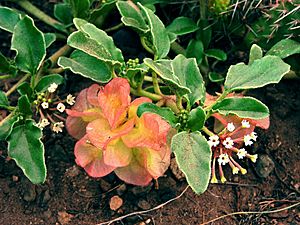Smallflower sandverbena facts for kids
Quick facts for kids Smallflower sandverbena |
|
|---|---|
 |
|
| In Great Sand Dunes National Park | |
| Scientific classification | |
| Synonyms | |
|
Abronia micranthus |
Tripterocalyx micranthus is a cool flowering plant. People often call it the smallflower sandverbena or small-flowered sand-verbena. It belongs to the four o'clock family.
This plant grows naturally in North America. You can find it from southern Alberta and Saskatchewan in Canada. It also grows across parts of the central United States. It reaches all the way to the desert areas in California, Arizona, and New Mexico. It likes places with sand, scrubby deserts, or sagebrush plants.
Contents
What Does Smallflower Sandverbena Look Like?
This plant stands upright and has many branches. It usually stays quite compact. Its stem can grow up to about 60 centimeters (about 2 feet) long. The stem is hairy and a bit sticky. It often has a reddish color.
Leaves of the Plant
Each leaf on the plant is green and feels a bit fleshy. It also has tiny hairs. The main part of the leaf can be up to 6 centimeters long. It sits on a long stalk called a petiole.
Flowers and How They Grow
The flowers of the smallflower sandverbena grow in a cluster. This cluster is called an inflorescence. Each flower is long and shaped like a trumpet. They can be pink or have a green tint.
Each flower can be up to 1.8 centimeters long. They are about half a centimeter wide at the opening. The flowers have 4 or 5 small parts called lobes. They grow on long, sticky stalks called pedicels. All these stalks connect to a small central spot.
Fruits of the Smallflower Sandverbena
After the flowers, the plant produces interesting fruits. These fruits have wide, thin "wings" that spread out. These wings often have a pattern like a net or small ribs. They extend from the main part of the fruit.

